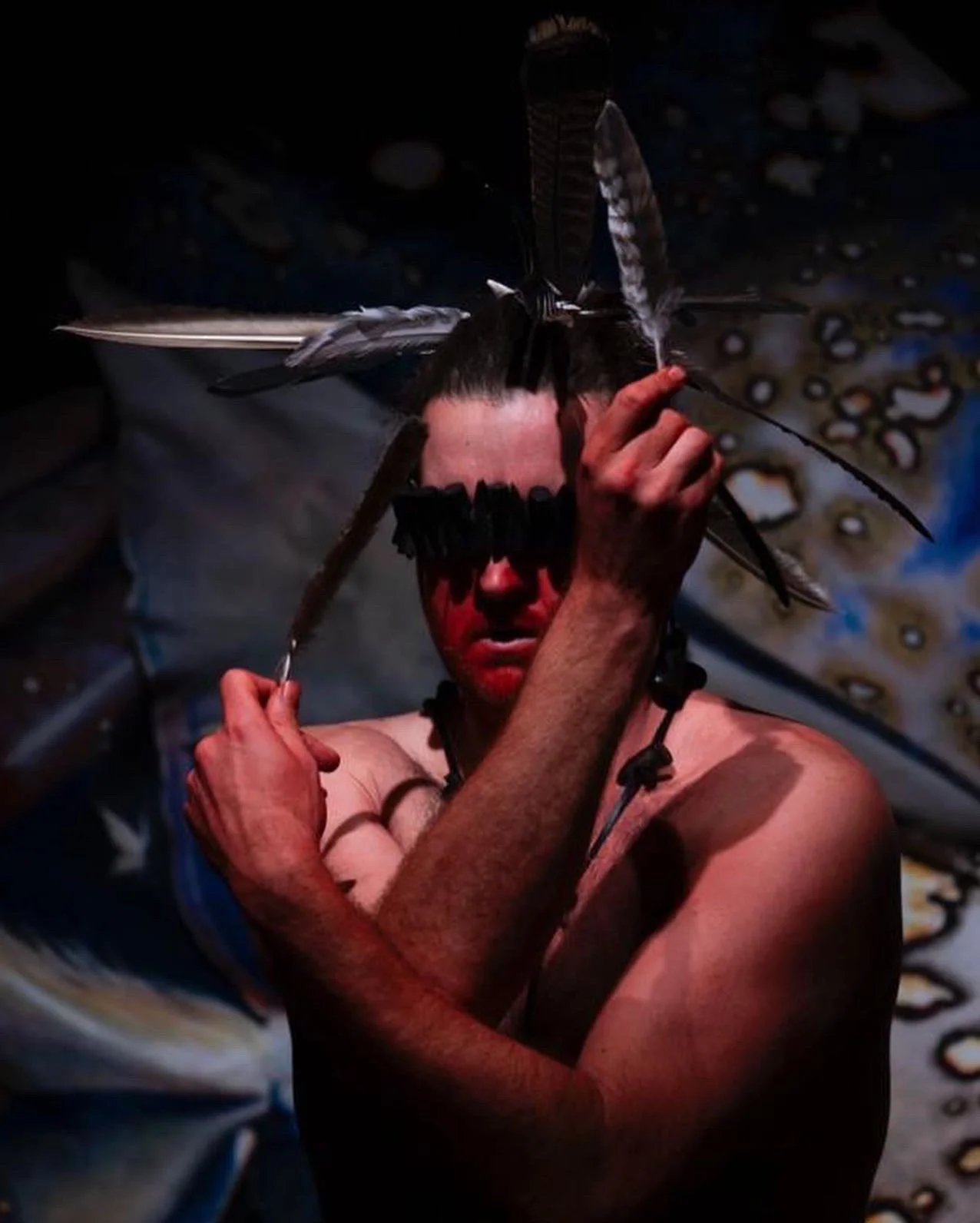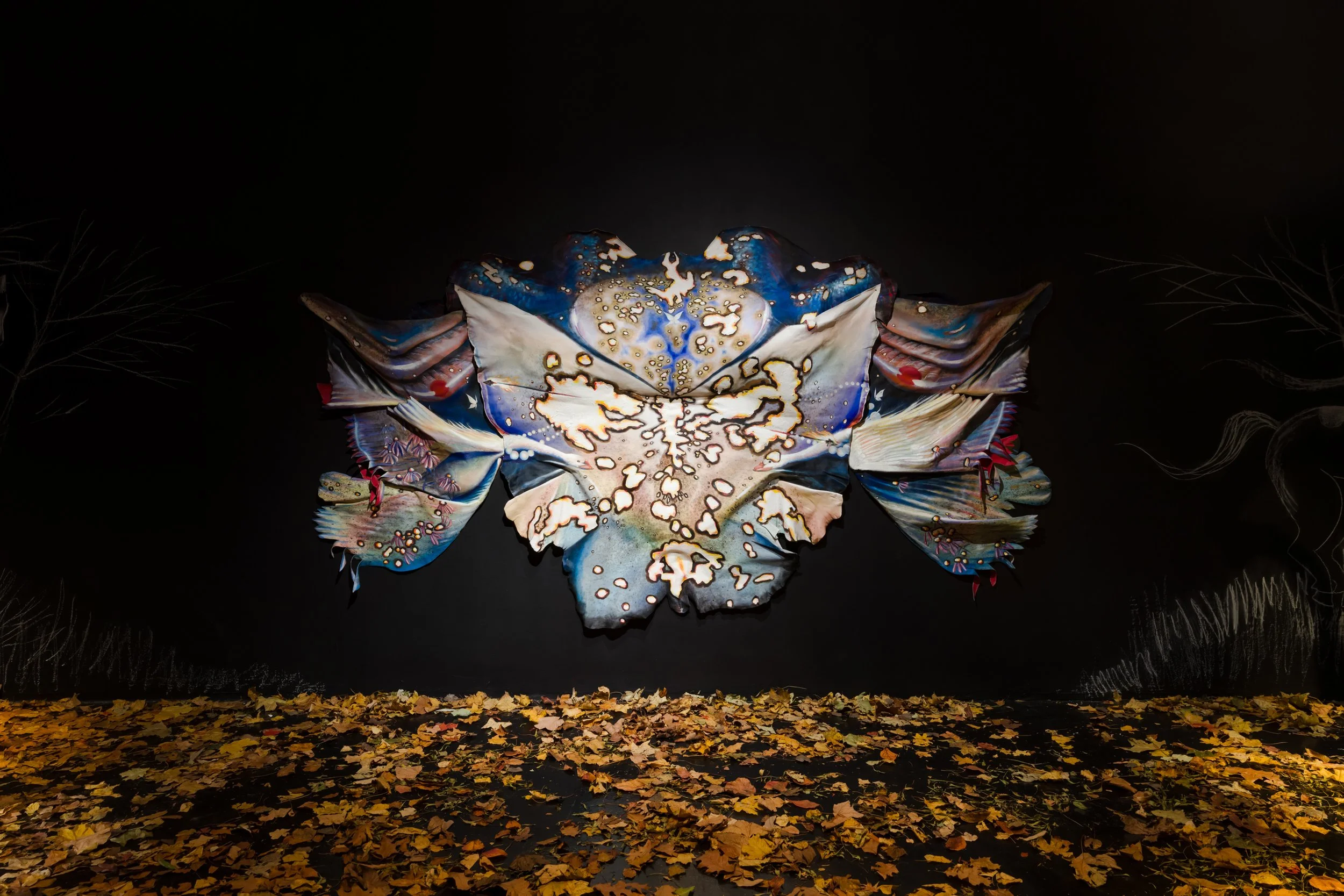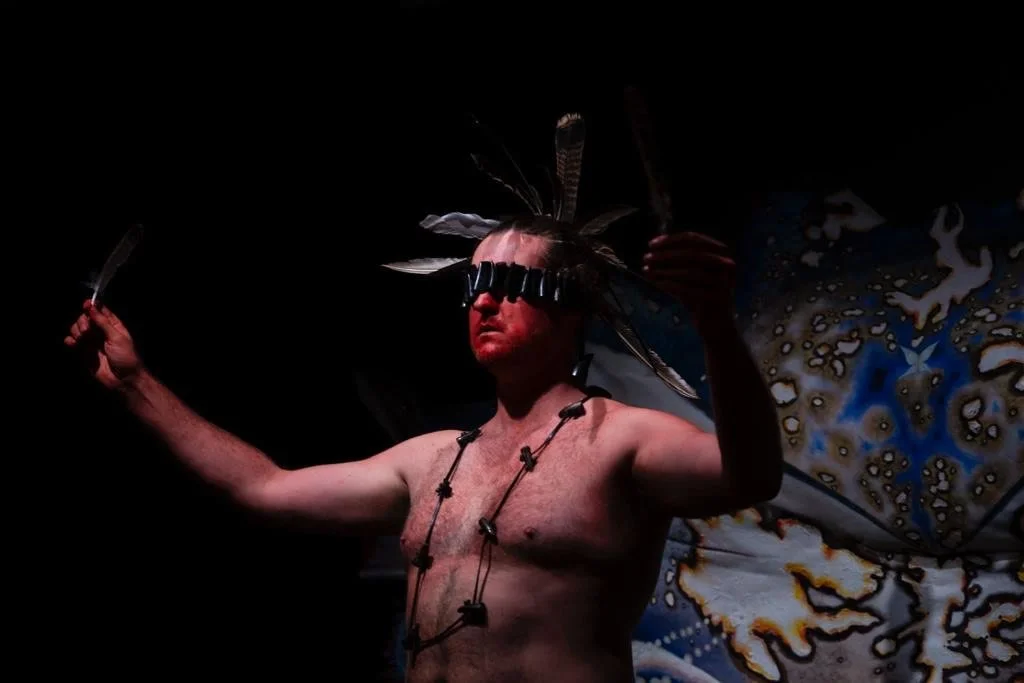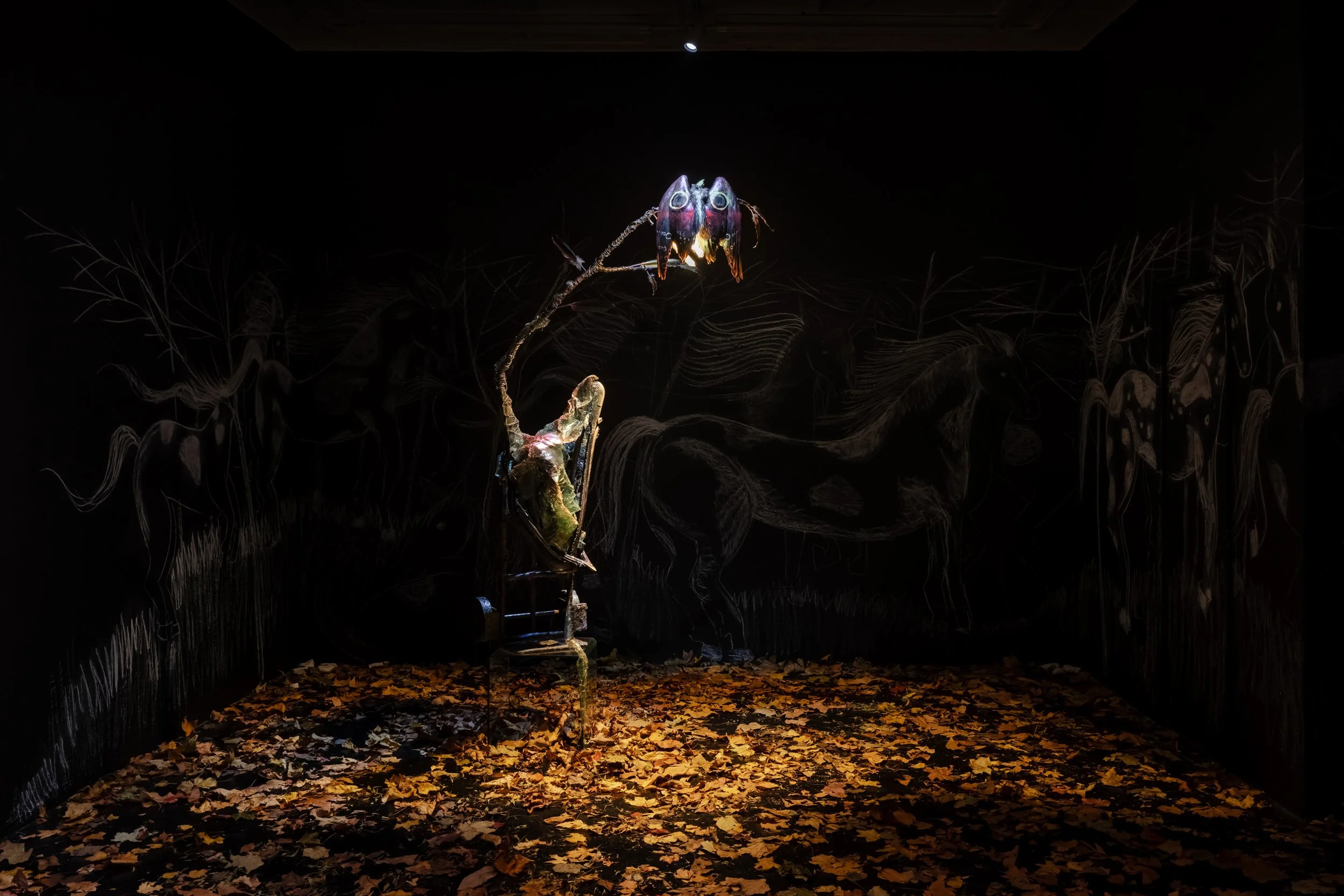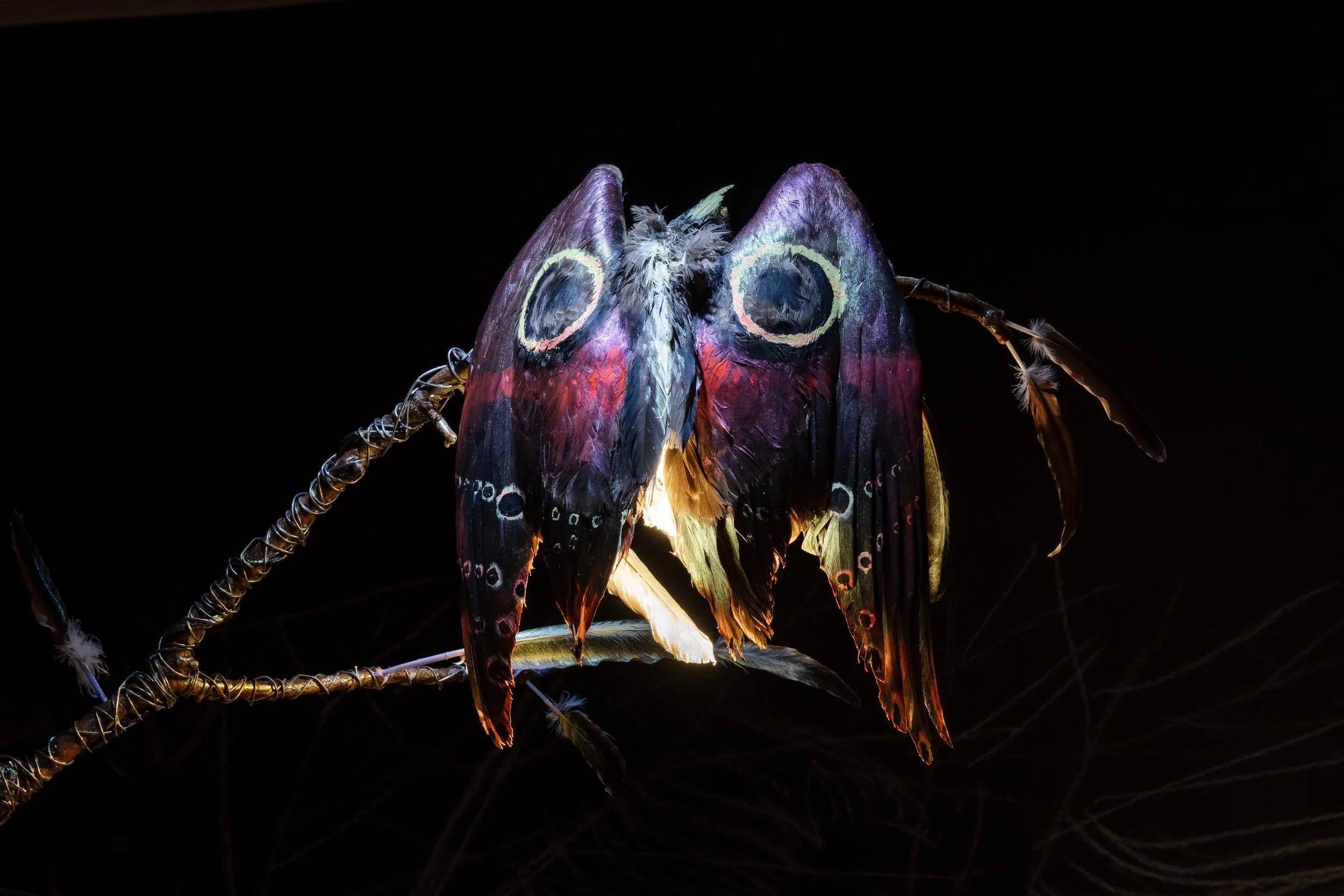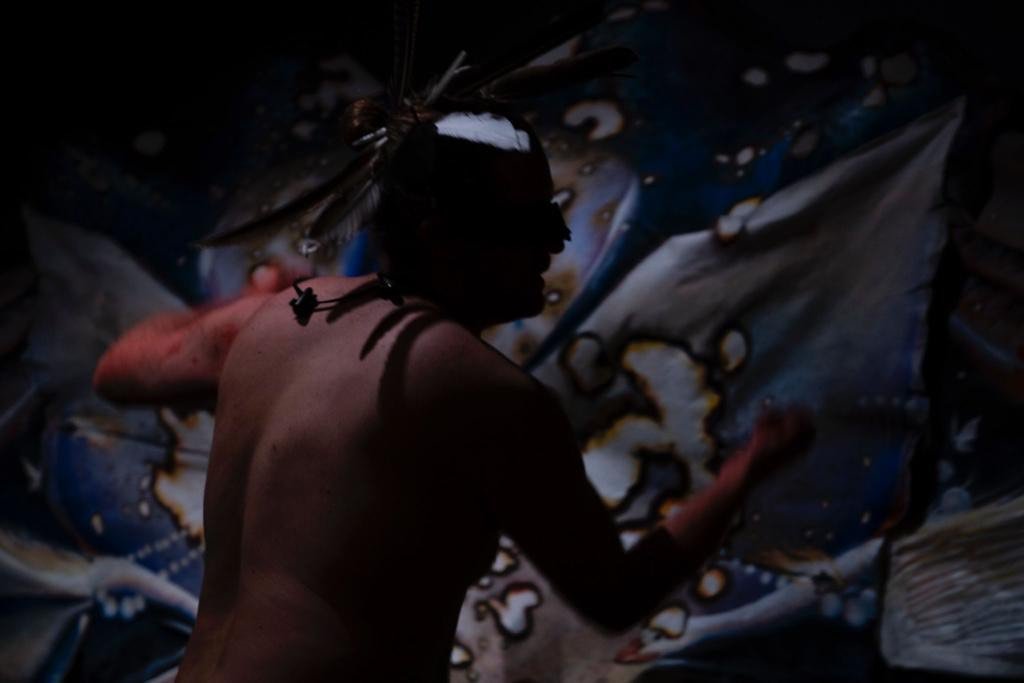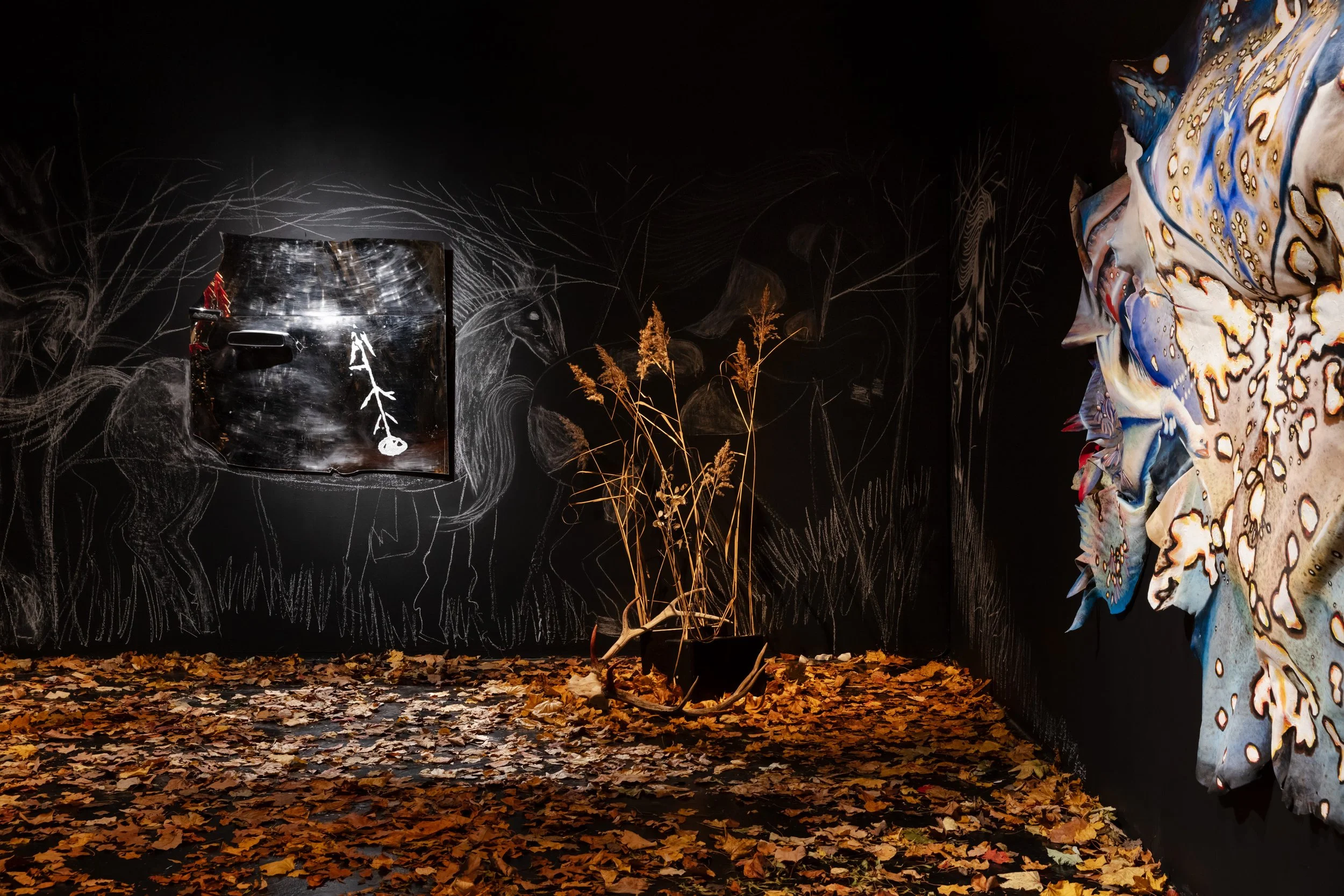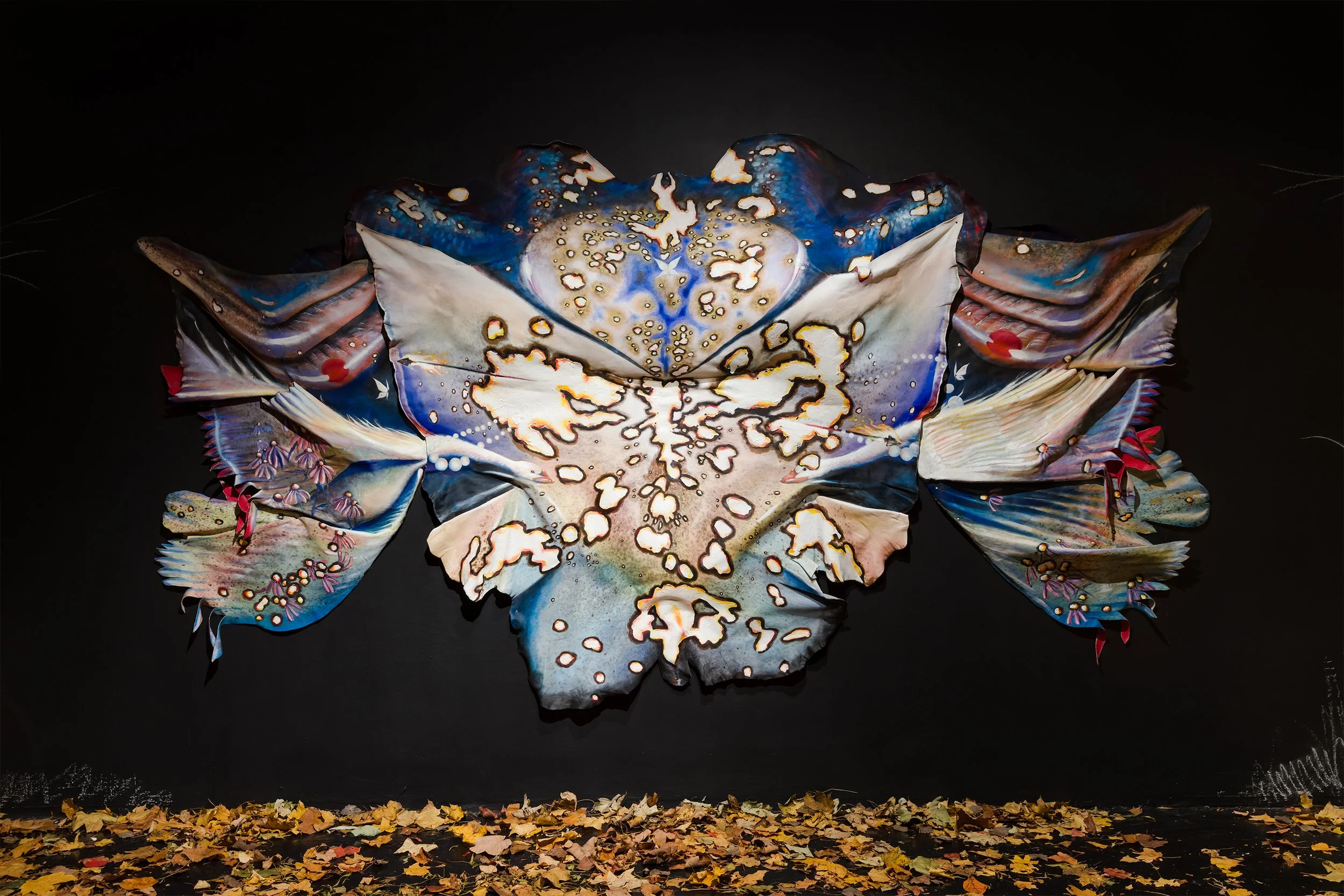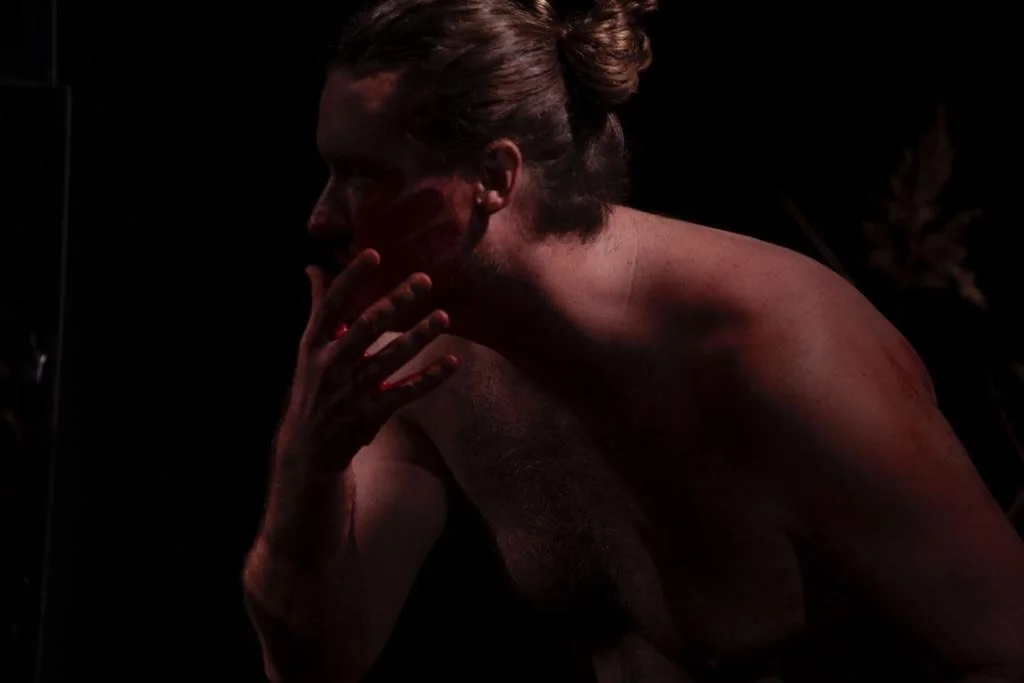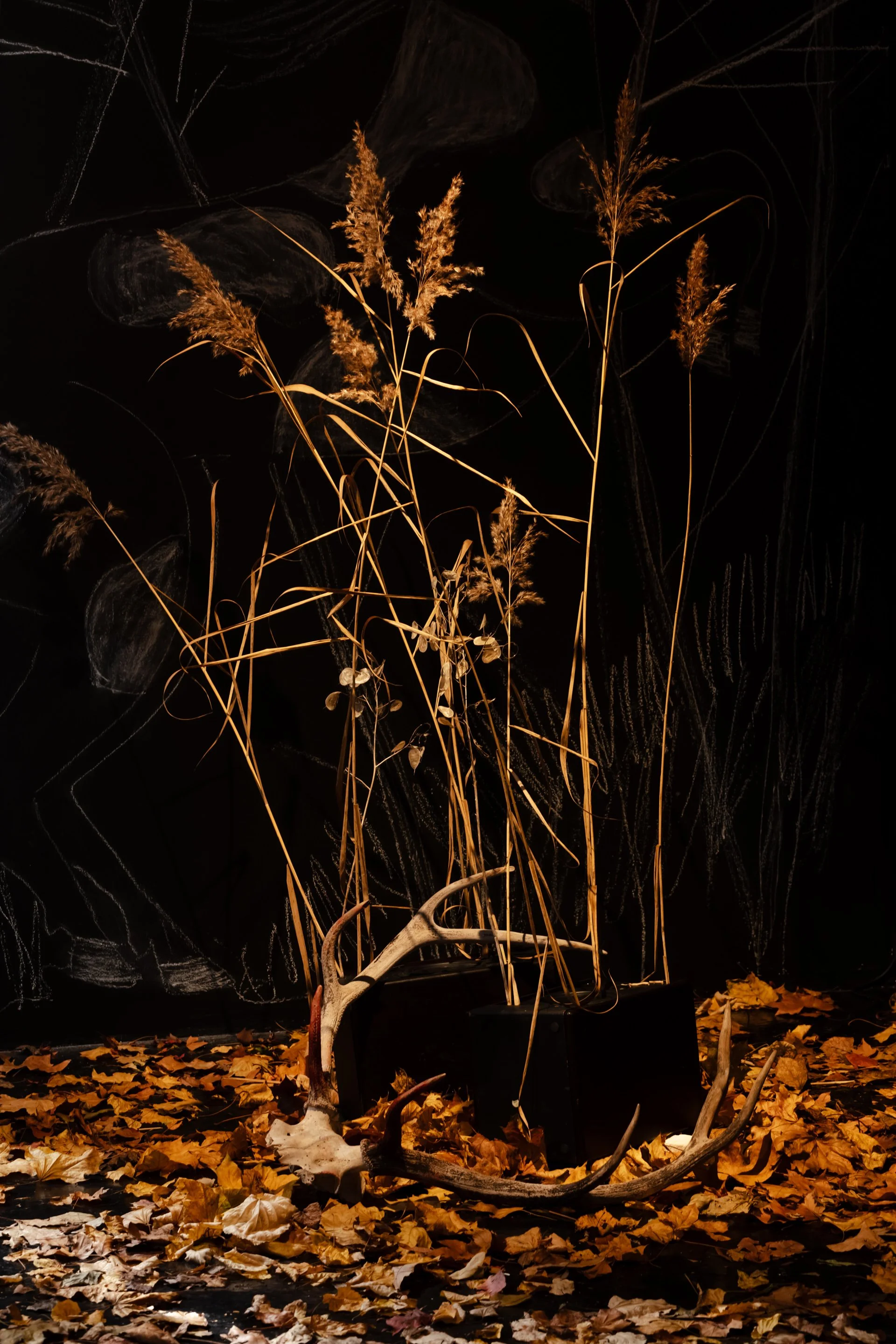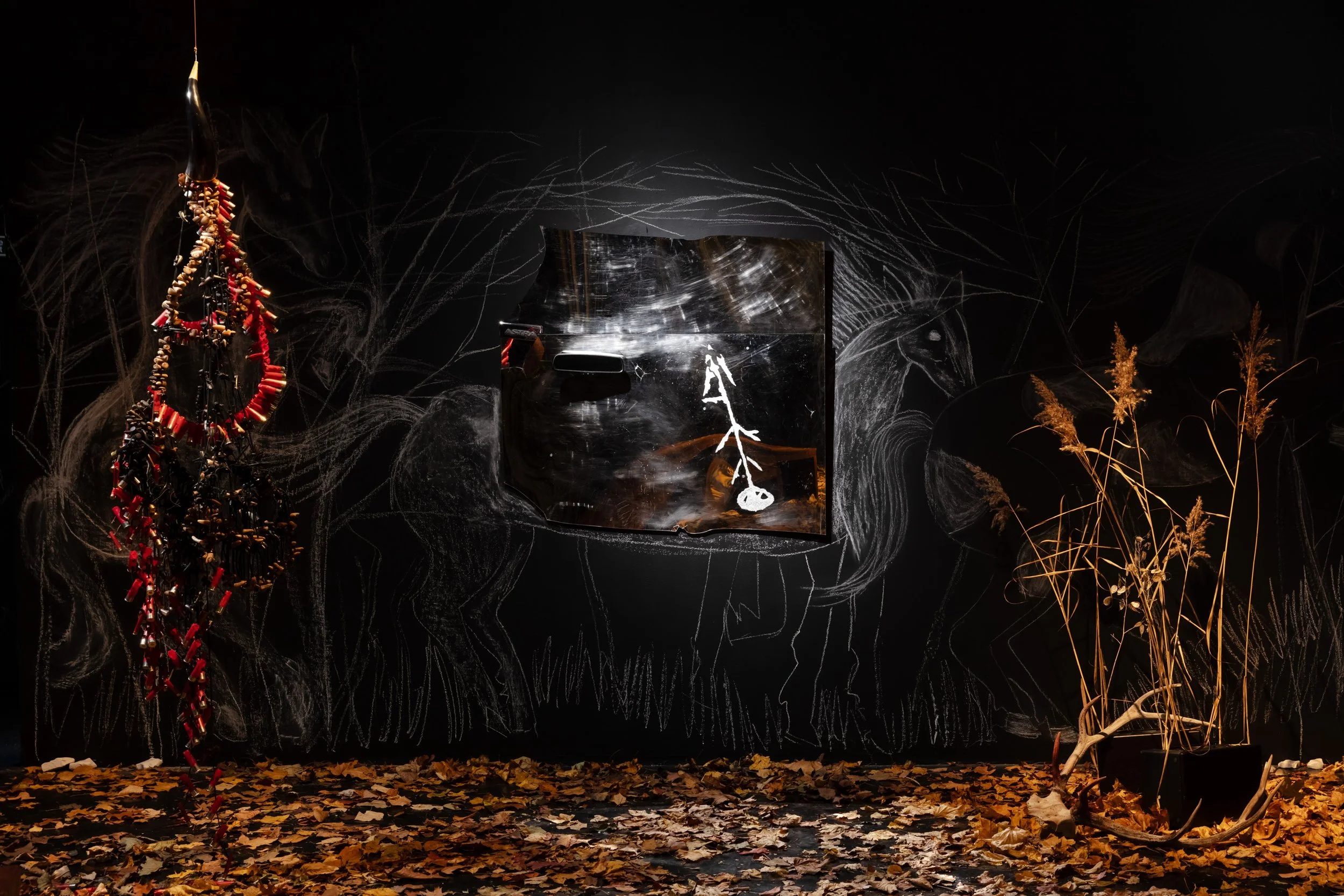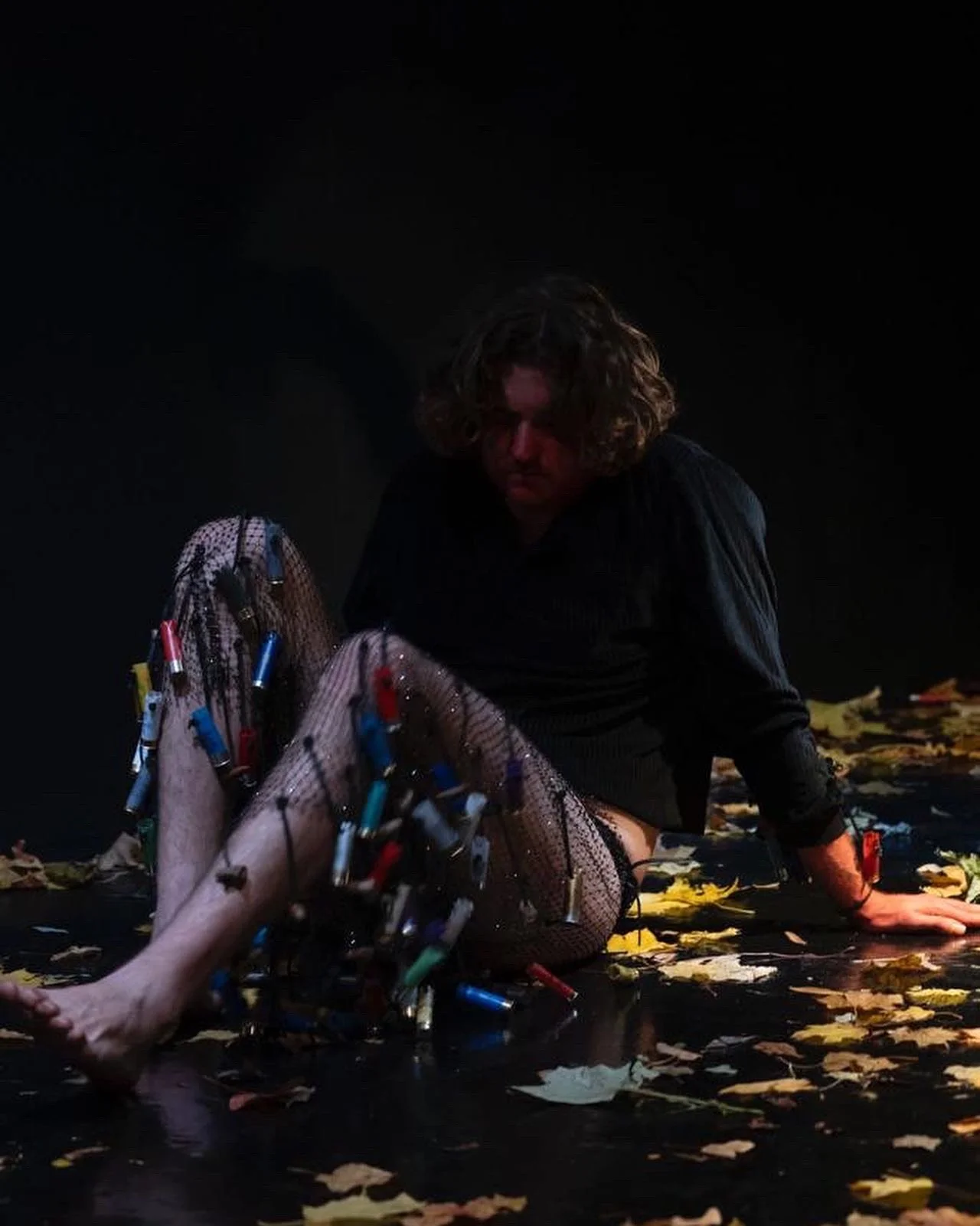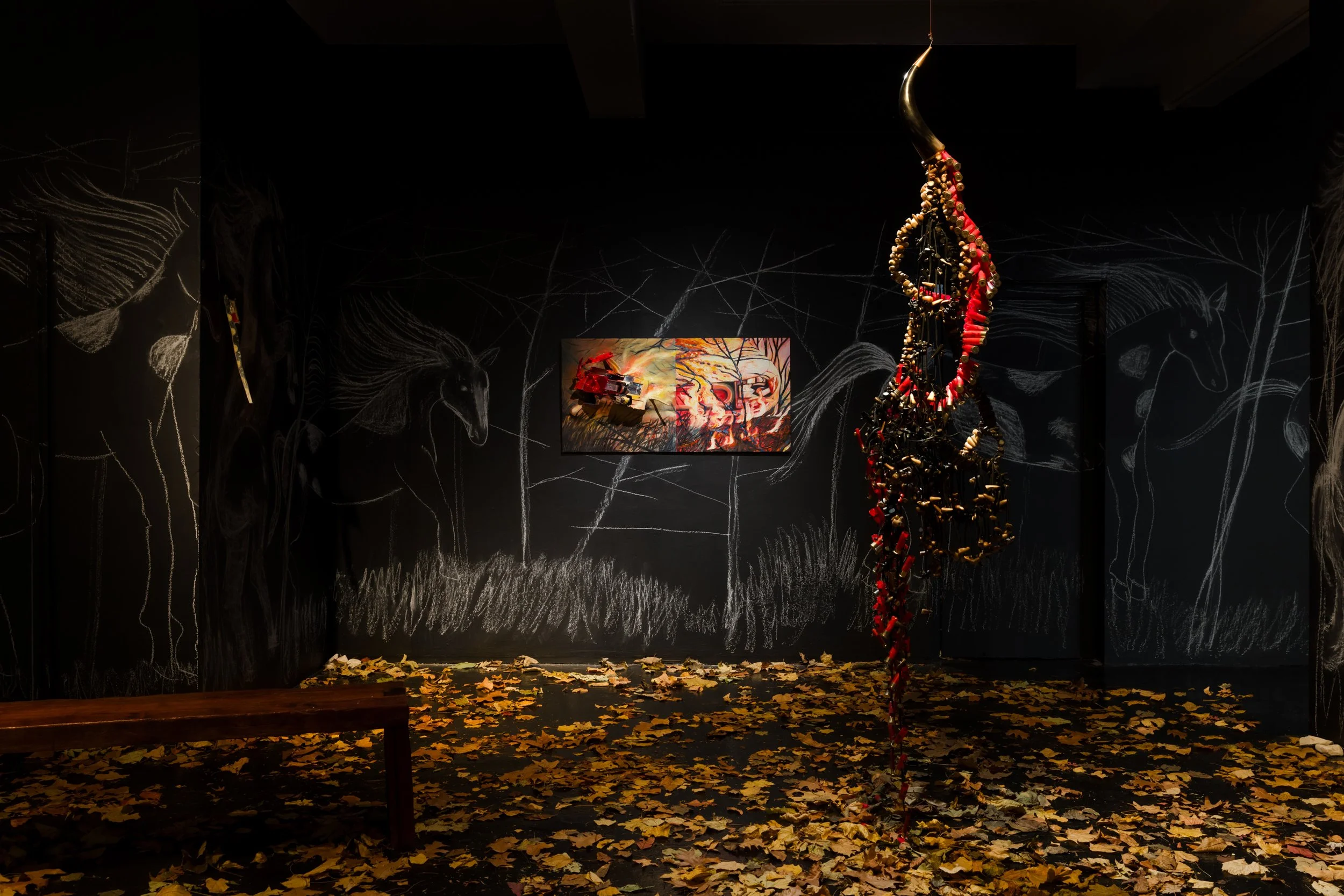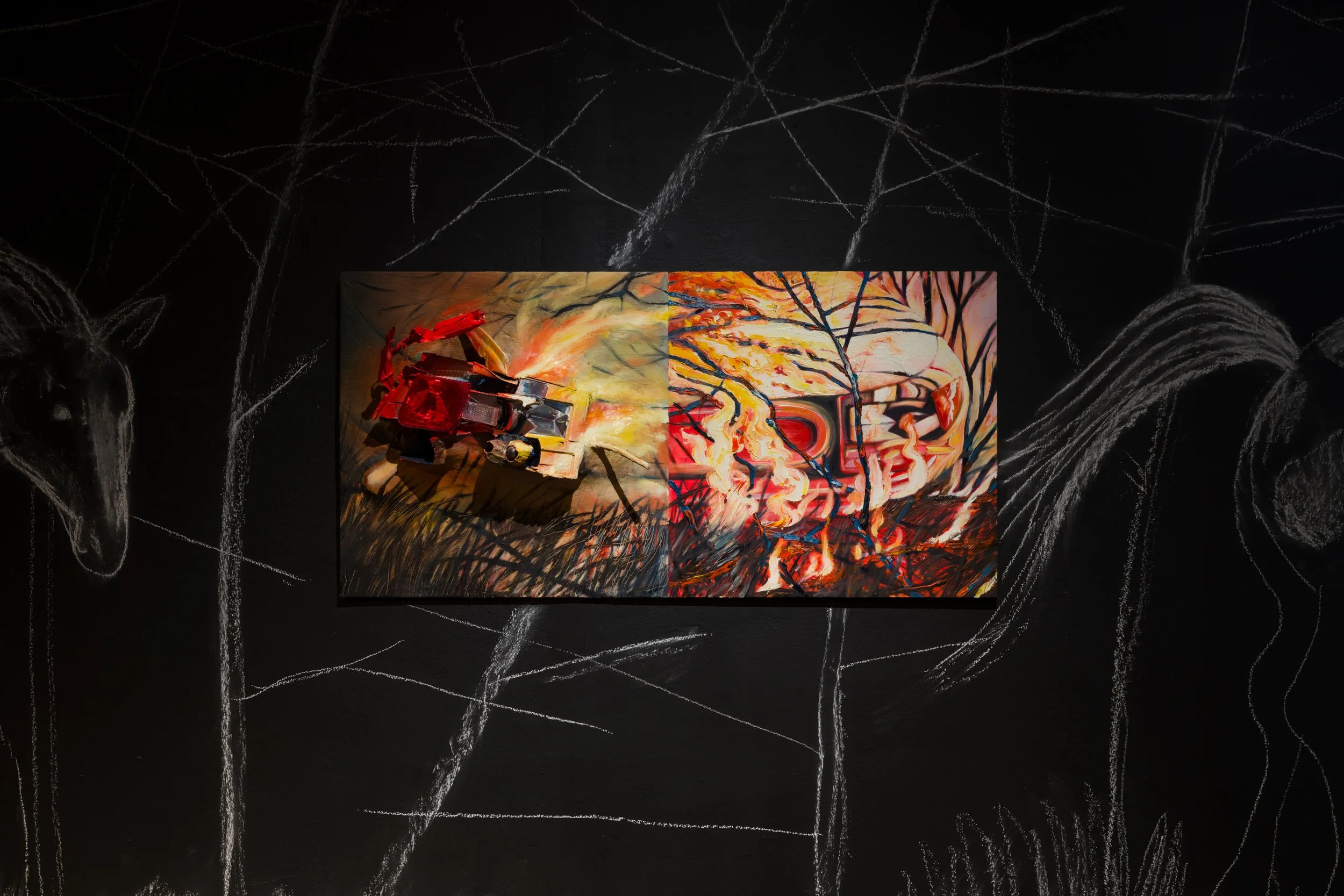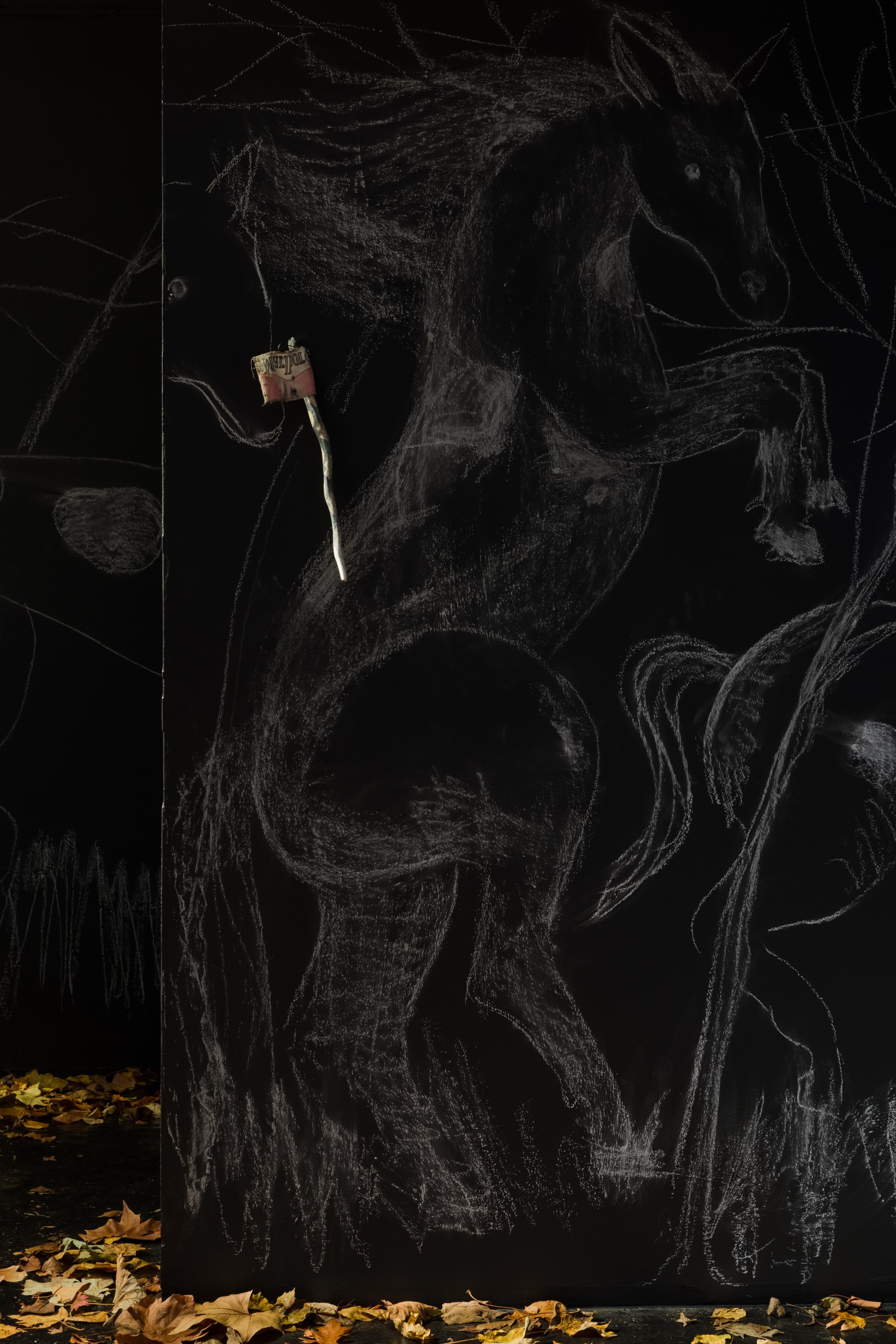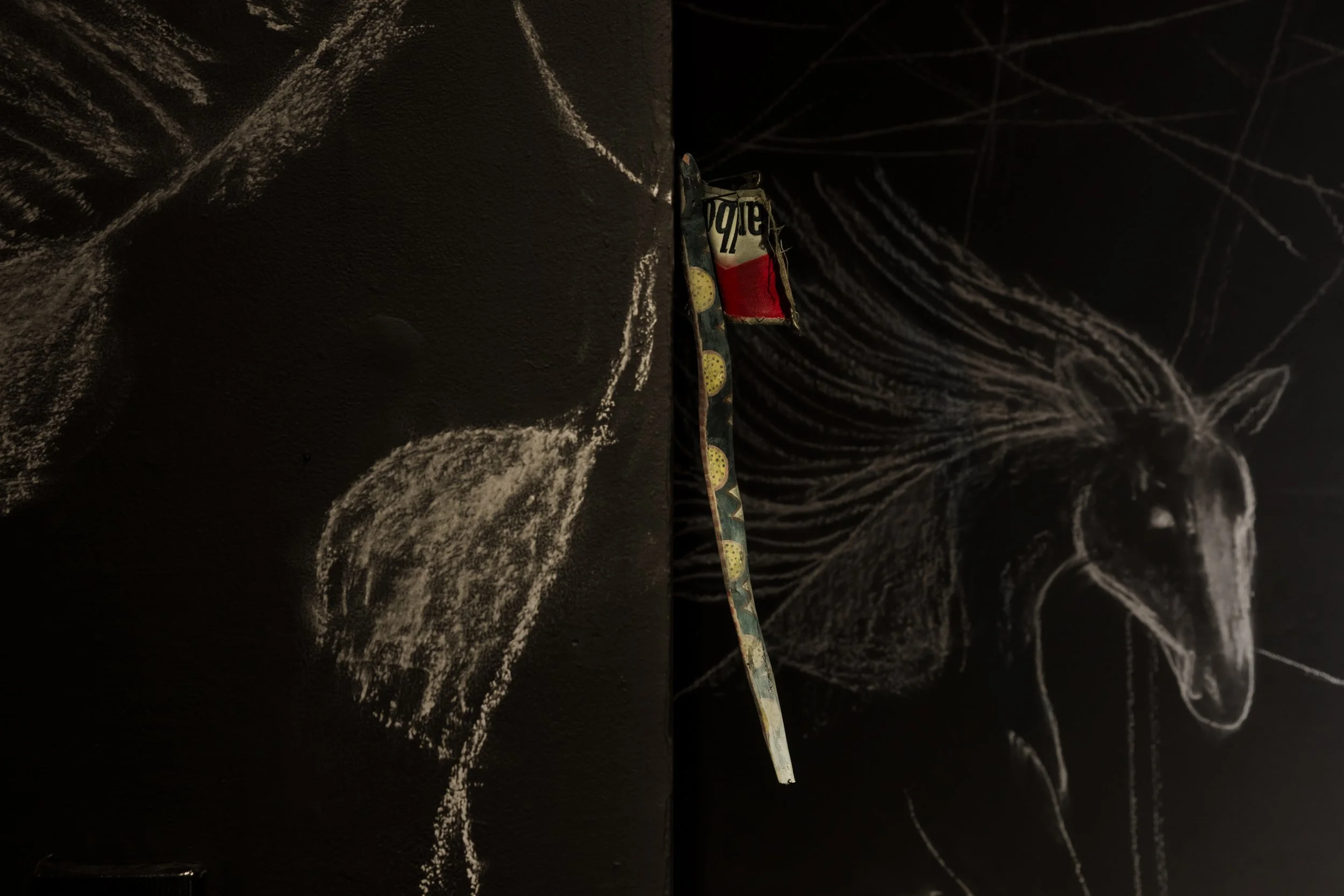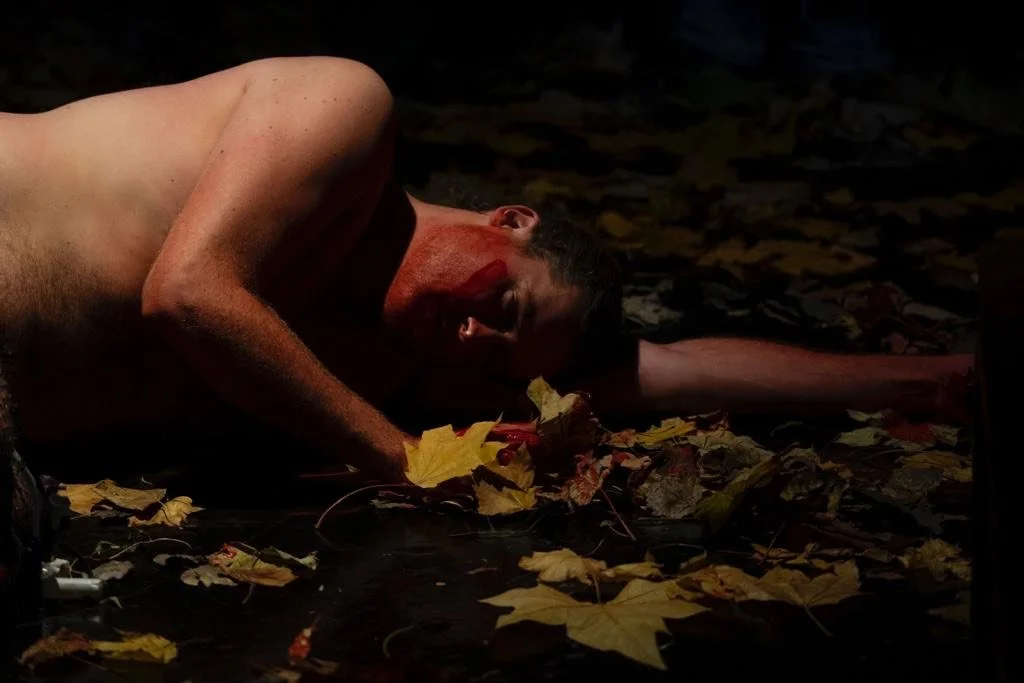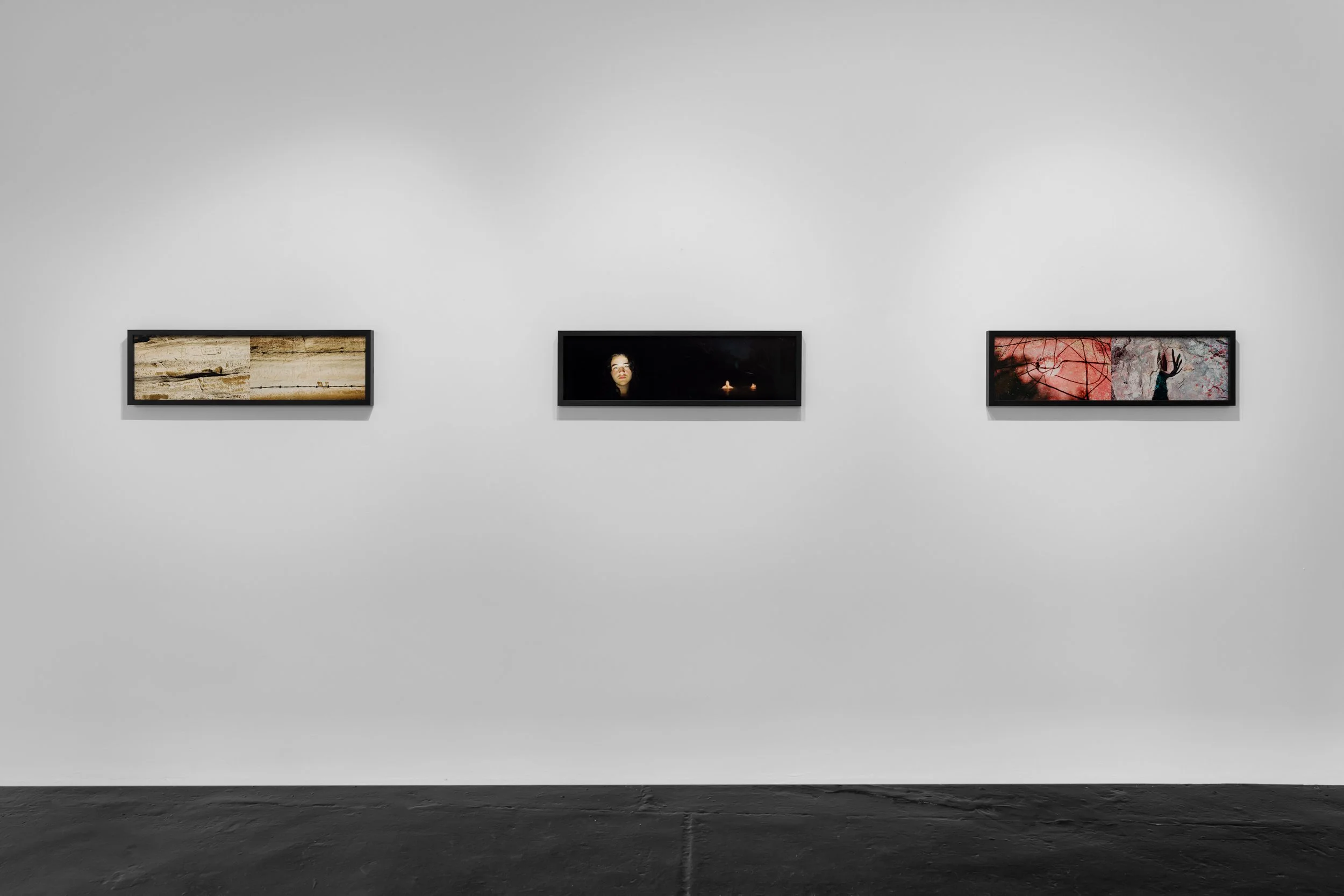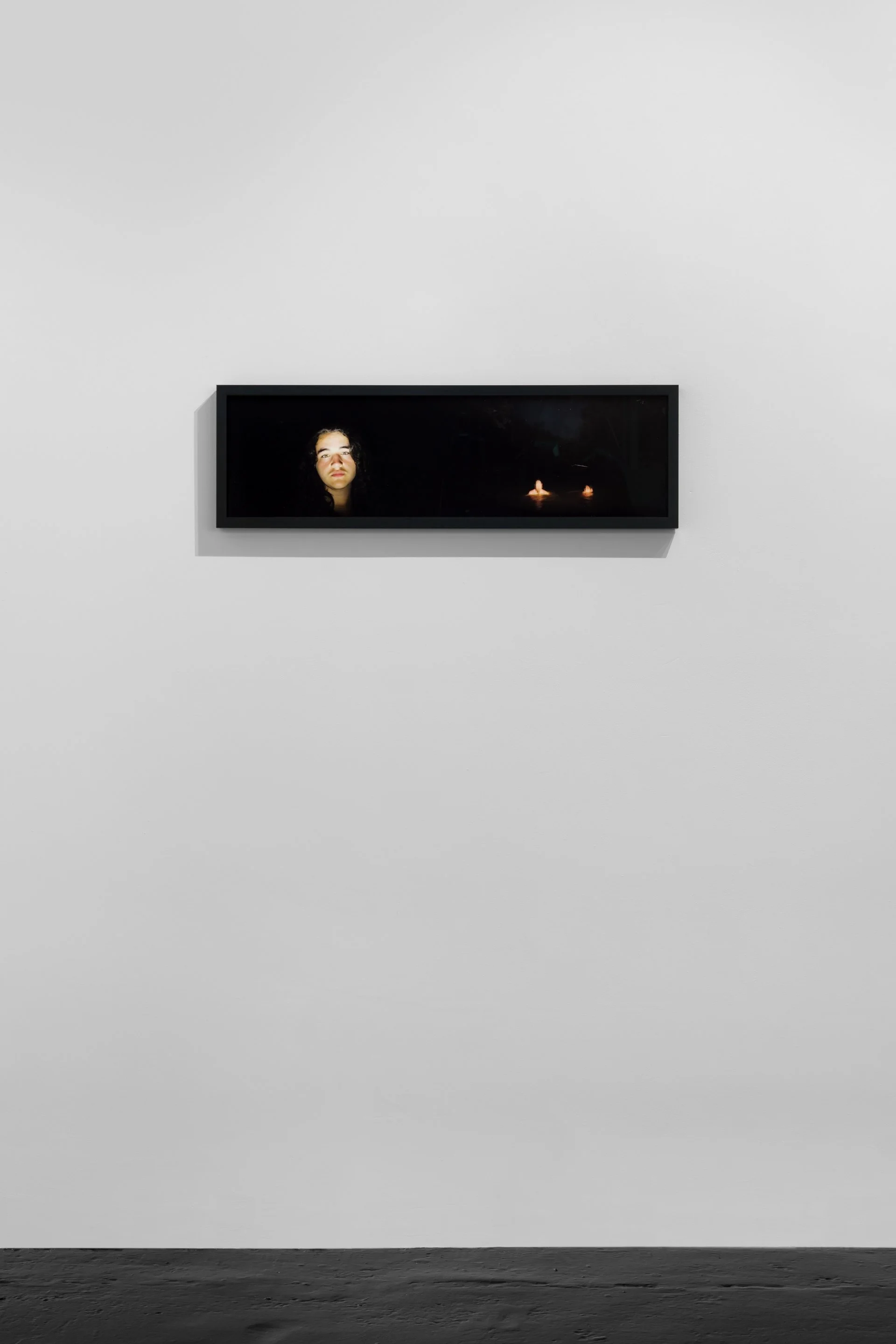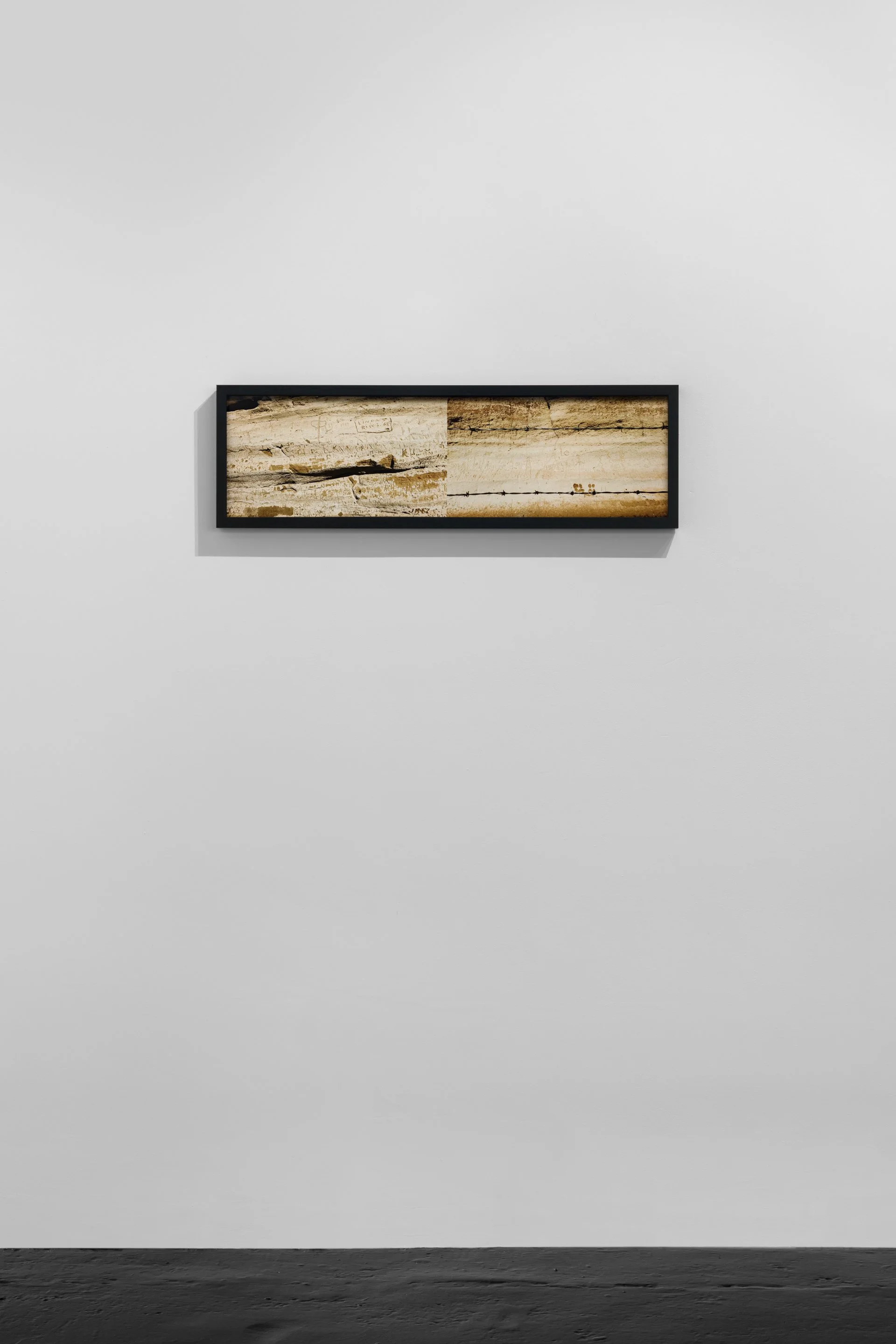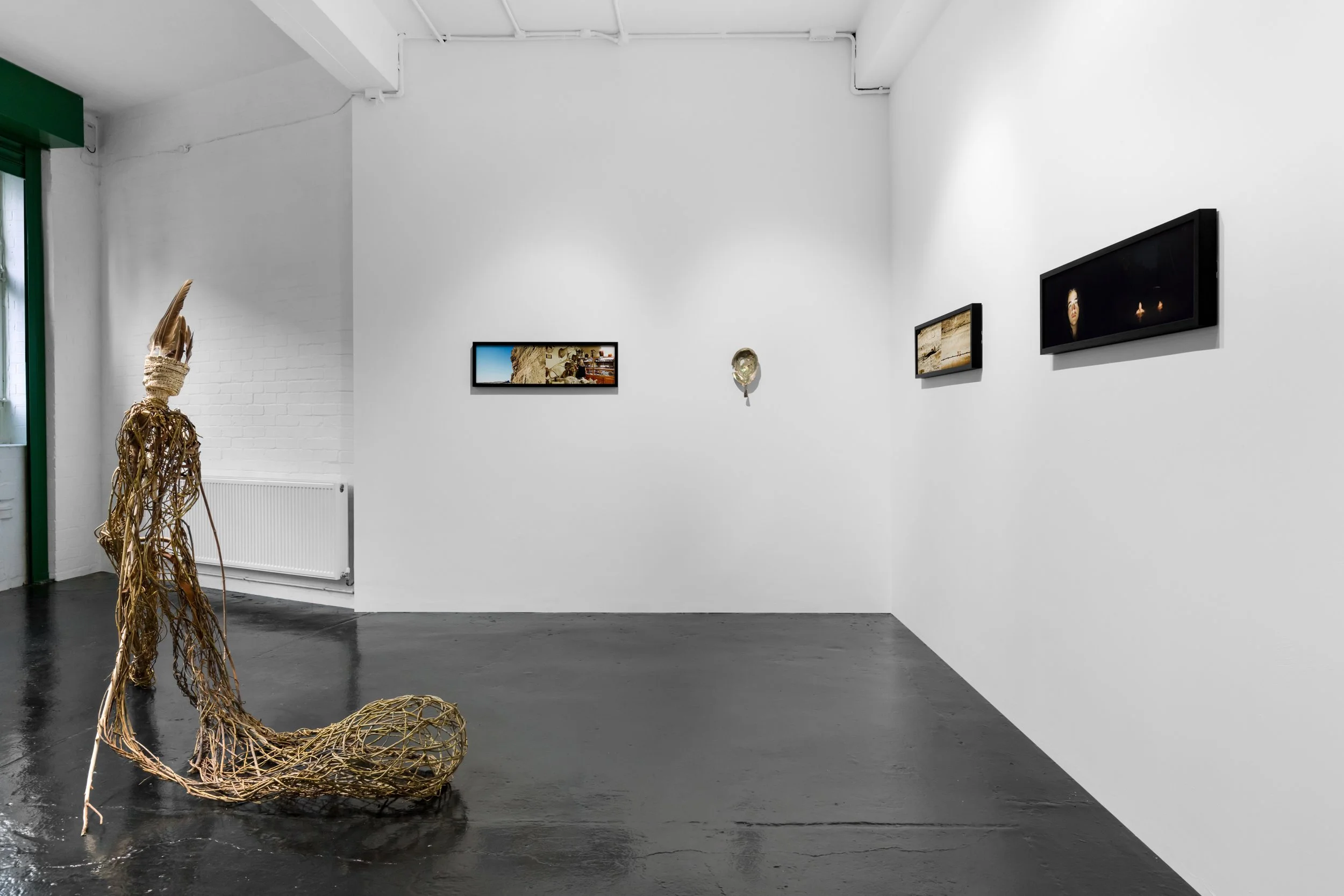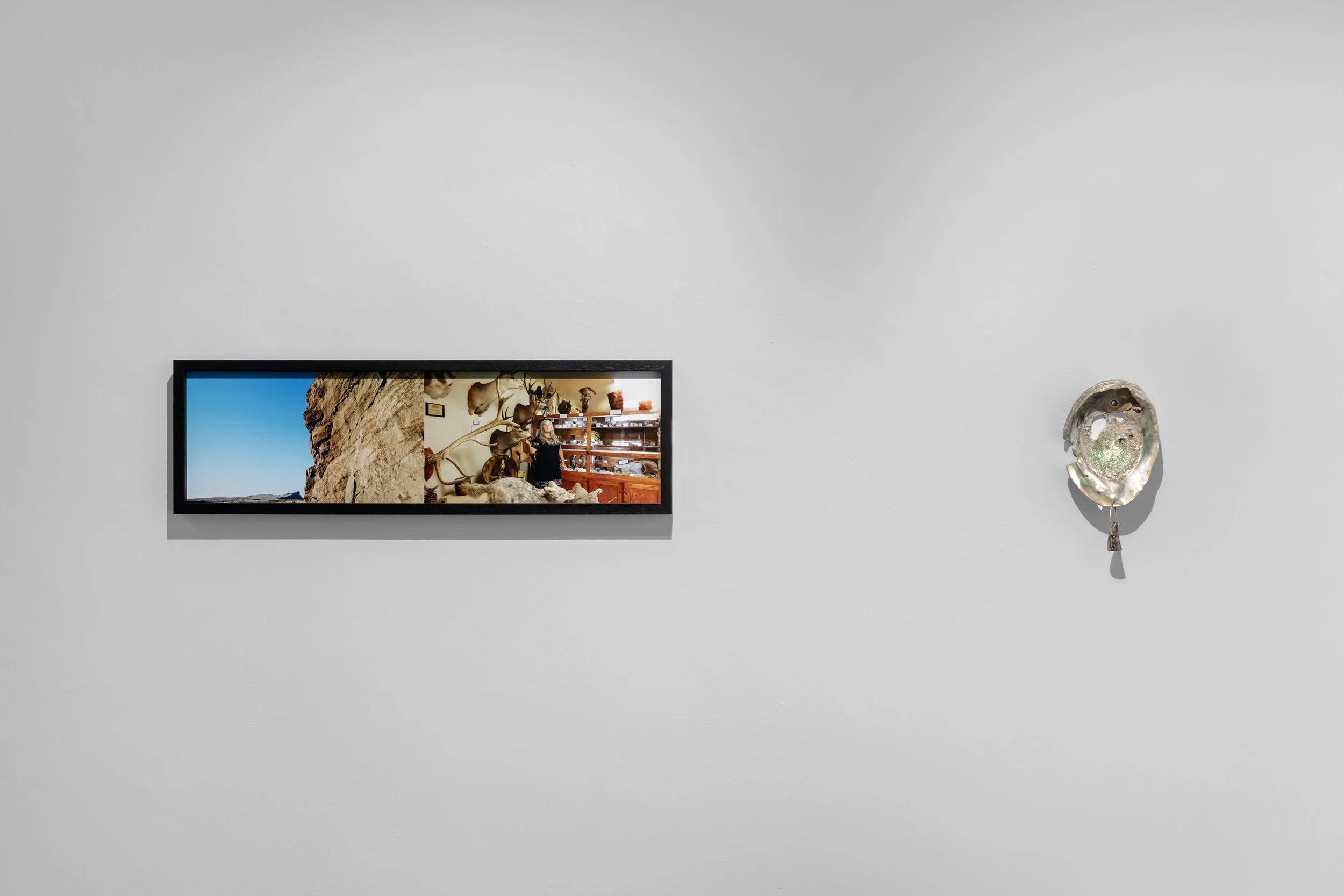all the world's horses
Performance, “Ínyana”, Nicoletti Contemporary, London, UK, 2023
“All The World’s horses”
opens with a 24 hr performance, comprising music, poetry and choreography. Tyler Eash's performance “Ínyana” is presented in an environment of sculpture, painting and photography exploring the silenced history of the artist's homeland of California via reflections on their own dual identity, which embodies descent from both the British Isle and Indigenous Californians, specifically Maidu.
The exhibition's title is inspired by the findings of Lakota Nakota Cheyenne scholar Dr. Yvette Running Horse Collin, whose research proved that horses were an integral part of Native culture before the arrival of Europeans. Questioning the colonial and Eurocentric paradigm that influenced the writing of North America’s history, All the World’s Horses evokes the challenges faced by the First Peoples of Turtle Island – the name given to North America in Indigenous cultures – in being heard, visible, and granted the authority to contribute to the history of their land and the world at large.
Eash takes the anthropological argument surrounding the apparition of horses on the continent of Turtle Island/North America as a point of departure to evoke their own struggle to decolonize their identity and retrieve their existence as a ‘2 Spirit’ — the way in which queer Natives are referred to, marked by the presence of masculine and feminine energies, which grants them cultural and spiritual roles that don’t exist in colonial cultures.
Conjuring a tension between the culture and aesthetics of ‘white’ working class California – what Indigenous people would term as ‘anglo-settler-colonialism’ –, and those of Maidu traditions, the works in All the World’s Horses grapple with the complexity of identity formation, which Eash addresses in relation to their reconnection with their own ancestral teachings, a process made difficult by the harsh reality of the California Genocide, which saw the Maidu population plummet from 10,000 to 330 between 1850 and 1870, as well as the ‘Act for the Government and the Protection of Indians’ that stripped the rights of natives and legalized native slavery in California.
In this context, the exhibition features a series of photographs documenting Eash’s research trip to Maidu and Modoc territories, showing, for instance, their mother in a Modoc museum, the portrait of a Maidu boy after a grieving ceremony, as well as ancient sacred petroglyphs vandalized with graffiti, and images of holes carved into Earth (used in healing ceremony to hold heated sacred rocks) and stone (used to grind acorns, one of the main food staples for Maidu).
These direct memories and experiences are then translated into a series of sculptural assemblages combining materials referring to anglo-settler-colonial aesthetics – e.g. a ‘Marlboro’ patch, a British hunting horn, shotgun shells–, with elements foraged in Maidu territory, such as vulture feathers, bear grass, and willow bark, paired with materials collected from London’s Lea River, including goose wings, a crashed windshield, a mossy discarded dolly and willow branches.
Exposing processes of extraction and appropriation – a number of works contain buffalo horn toggles from the brand Burberry, and another uses a Sir Terence Conran glass table as a plinth, both symbolizing British luxury and popular culture –, these sculptures are accompanied by paintings on cowhide, a material alluding to life conditions in rural California, as well as Indigenous culture, in which it has historically been used to make paintings. Entitled Angel/Kákkini, these works address the artist’s multi-ethnicity by revisiting the biblical figure of the angel, departing from its European representation as a human-like being to reconnect with its translation in Maidu (‘Kákkini’) as a benevolent spirit who communes in the dance house with the shaman. In this tradition ‘angels’ impart themselves as an apparition and are regarded as an abstraction that symbolizes the holiness of nature and the inherent power of psyche and spirit.
Through these processes of mixing and reshuffling materials, iconographies and stories, Eash addresses the violence, poverty, and issues of cultural erasure facing the First Peoples of Turtle Island, using spirituality and historical references to evoke their mode of perceived existence as ‘living ghosts’: a way of life defined by a desire to embody the blessed and traumatic memories of ancestors while being denied the basic material condition of subsistence and expression.
Camille Houzé, Director, Nicoletti Contemporary
“Angel / Kákkini #6”, 2023 acrylic and oil painting on cowhide, cotton padding on wood backing 203 x 370 x 15 cm / 80 x 146 x 6 in
Performance, “Ínyana”, Nicoletti Contemporary, London, UK, 2023
“River / Sewí”, 2023 Terence Conran glass table, dolly found in canal, found rubber car window frame, found crashed windshield, tree branch, iron wire, resin, acrylic paint, colour flip automotive paint, feathers, goose wings 250 x 135 x 93 cm / 98.5 x 52 x 36.5”
“River / Sewí”, 2023 Terence Conran glass table, dolly found in canal, found rubber car window frame, found crashed windshield, tree branch, iron wire, resin, acrylic paint, colour flip automotive paint, feathers, goose wings 250 x 135 x 93 cm / 98.5 x 52 x 36.5”
“River / Sewí”, 2023 Terence Conran glass table, dolly found in canal, found rubber car window frame, found crashed windshield, tree branch, iron wire, resin, acrylic paint, colour flip automotive paint, feathers, goose wings 250 x 135 x 93 cm / 98.5 x 52 x 36.5”
Performance, “Ínyana”, Nicoletti Contemporary, London, UK, 2023
left to right: “Ancestors / Hínwo Hóyyam Máidu”, “Ínyana” sound installation, “Angel / Kákkini #6”
“Angel / Kákkini #6”, 2023 acrylic and oil painting on cowhide, cotton padding on wood backing 203 x 370 x 15 cm / 80 x 146 x 6 in
Performance, “Ínyana”, Nicoletti Contemporary, London, UK, 2023
“Ancestors / Hínwo Hóyyam Máidu”, 2023 acrylic mirror, found metal “astra” car logo, rear view mirror, screws, wood backing 113 x 122 x 15 cm / 44.5 x 48 x 6 in
“Ínyana” installation, 2023 speakers, dried grass and herbs, red deer antlers
left to right “Field / Koyó”, 2023, “Ancestors / Hínwo Hóyyam Máidu”, 2023, “Ínyana” installation, 2023
“Field / Koyó”, 2023 brass and horn British hunting horn, iron wire, leather ties, Burberry buffalo horn toggles, shotgun shells 240 x 51 x 33 cm / 94.5 x 20 x 13 inches
Performance, “Ínyana”, Nicoletti Contemporary, Loondon, UK, 2023
“Paradise Fires”, 2023 & “Field / Koyó”, 2023
“Paradise Fires”, 2023 oil and acrylic paint on plaster, wood, wire, found car headlight, silk flower 60.5 x 123 x 17 cm / 24 x 48.5 x 6.5 inches
Performance, “Ínyana”, Nicoletti Contemporary, London, UK, 2023
“Flag for Dying Languages”, 2023 carved wooden snake, acrylic paint, safety pin, nails, “Marlboro” patch 43 x 18 x 13 cm / 17 x 7 x 5 inches
“Flag for Dying Languages”, 2023 carved wooden snake, acrylic paint, safety pin, nails, “Marlboro” patch 43 x 18 x 13 cm / 17 x 7 x 5 inches
Performance, “Ínyana”, Nicoletti Contemporary, London, UK, 2023
left to right “Graffiti and Petroglyphs”, 2023, “After Ceremony for Fallen Sister”, 2023, “Sweat Lodge and Mortar Stone”, 2023
“After Ceremony for Fallen Sister”, 2023 giclée print on cotton paper with Baryta coating, custom painted wood frame (photo) 24 x 84 cm / 9.5 x 33 inches
“Sweat Lodge and Mortar Stone”, 2023 giclée print on cotton paper with Baryta coating, custom painted wood frame (photo) 24 x 84 cm / 9.5 x 33 inches
“Graffiti and Petroglyphs”, 2023 giclée print on cotton paper with Baryta coating, custom painted wood frame (photo) 24 x 84 cm / 9.5 x 33 Inches
left to right “Warrior / Hudési”, 2023. “Kamookumputz and Yawónope”, 2023, “Ear for Unheard Tongues”, 2023, “Graffiti and Petroglyphs”, 2023, “After Ceremony for Fallen Sister”, 2023
“Kamookumputz and Yawónope”, 2023 & “Ear for Unheard Tongues”, 2023
“Kamookumputz and Yawónope”, 2023. giclée print on cotton paper with Baryta coating, custom painted wood frame. (photo) 24 x 84 cm / 9.5 x 33 inches
“Ear for Unheard Tongues”, 2023 carved abalone shell, found hoop earring, Burberry buffalo horn toggle, nails. 29.5 x 16.5 x 7 cm / 11.6 x 6.5 x 2.8 inches
“Warrior / Hudési”, 2023 Head: foraged bear grass, white willow bark and vulture feathers from Maidu territory, Body: Willow branches from Lea River. 178 x 226 x 95 cm / 70 x 89 x 37.5 inches
